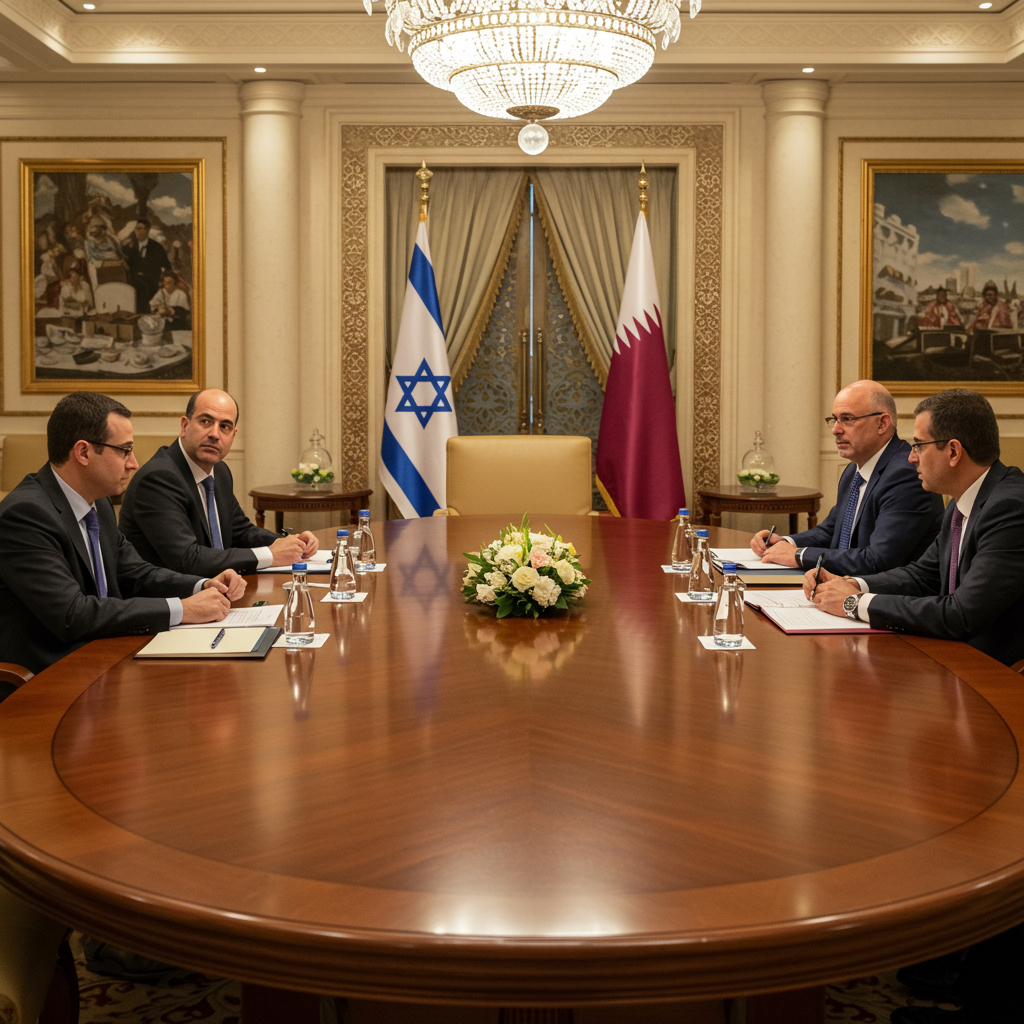Israel decided Sunday to dispatch a team to Qatar. The delegation will engage in proximity talks with Hamas. these discussions center on the most recent proposal for a Gaza ceasefire and the release of hostages held in the territory. This move occurs despite Prime Minister Benjamin Netanyahu describing Hamas’s proposed changes to the plan as “unacceptable.” Mediators from Qatar, the United States, and Egypt presented the original proposal.
The decision highlights the complex and often contradictory nature of efforts to pause hostilities and secure the return of captives. While key disagreements persist, the willingness to continue dialogue suggests a narrow pathway might still exist amidst significant obstacles. Observers worldwide are watching closely, hoping diplomacy can succeed where conflict has brought immense suffering.
The Path to Talks: A Difficult Decision
Prime Minister Benjamin Netanyahu’s office confirmed his approval Sunday. He directed acceptance of the invitation for indirect talks. This instruction came “in light of an assessment of the situation.” Netanyahu had stated Friday night that “the changes that Hamas is seeking to make” to the proposed deal were “unacceptable to Israel.”
Sending negotiators signals Israel’s intent. The primary goal remains securing the return of israeli hostages. The talks in Qatar will build upon the framework of the Qatari proposal. Israel had previously agreed to this specific plan. The negotiating team was expected to leave for Doha Sunday. An earlier statement from an Israeli official suggested a flicker of possibility. The official briefed local media, indicating there was “something to work with” in Hamas’s response. This hints at nuances beneath the public stance of rejection.
Hamas’s Stance and Key Demands
Hamas communicated its position Friday night. The group announced it had delivered a “positive response” to the ceasefire proposal. They also declared readiness to negotiate the terms. The proposal outlines a potential 60-day cessation of fighting. However, Hamas sought significant amendments to the mediators’ plan.
According to a Palestinian official familiar with the discussions, Hamas made several key demands:
Hostilities Guarantee: They sought a firm guarantee that Israeli military operations would not resume. This guarantee is crucial even if talks on a permanent truce following the ceasefire fail. This addresses concerns about the temporary nature of a 60-day pause.
Aid Distribution Control: Hamas demanded that humanitarian aid entering Gaza be distributed solely by the United Nations and its partners. They specifically called for an immediate end to the operations of the Gaza Humanitarian Foundation (GHF). The GHF is an aid organization backed by both Israel and the United States.
Troop Withdrawal: Another key amendment concerned the positioning of Israeli forces. Hamas requested Israeli troops withdraw to the positions they held before the previous ceasefire collapsed in March. This differs from the phased pull-outs from specific areas of Gaza believed to be included in the mediators’ plan.
US Assurance: The group also reportedly sought a direct guarantee from the United States. This guarantee would specifically prevent the resumption of Israeli air and ground operations after any temporary ceasefire.
These demands represent major sticking points. They reflect Hamas’s desire for a more comprehensive and lasting halt to the conflict than reportedly outlined in the initial proposal.
The Proposed Deal: Mediator’s Blueprint
The proposal drafted by mediators from Qatar, the US, and Egypt offers a framework for de-escalation. It is believed to outline a 60-day ceasefire period. During this time, both parties would work towards a more durable end to the intense fighting.
Key components of the potential agreement reportedly include:
Hostage-Prisoner Exchange: The plan is thought to involve a staggered release of hostages held by Hamas. Specifically, 10 living Israeli hostages and the bodies of 18 other hostages would be released. This would occur in exchange for Palestinian prisoners currently held in Israeli jails. Fifty Israeli hostages are still believed to be in Gaza. At least 20 of these are thought to be alive.
Humanitarian Aid: The proposal reportedly stipulates that substantial quantities of humanitarian aid would enter Gaza immediately. The involvement of trusted international bodies like the UN and the International Committee of the Red Cross (ICRC) is included. This aims to address the severe humanitarian crisis in the territory.
Negotiation Process: Mediators are expected to guarantee that serious negotiations towards a permanent resolution will begin from the first day of the ceasefire. The proposal is also believed to allow for extending the ceasefire period if necessary. This provides flexibility for sensitive long-term discussions.
This blueprint forms the basis for the current proximity talks. Mediators face the challenging task of aligning Hamas’s requested amendments with terms acceptable to Israel.
Bridging the Divide: Challenges and Positions
The chasm between Hamas’s demands and Israel’s stated objectives presents a significant hurdle. Israeli Prime Minister Benjamin Netanyahu maintains a clear and firm position. He has repeatedly ruled out ending the war under current conditions. His conditions require the full release of all Israeli hostages. He also demands the destruction of Hamas’s military and governing capabilities.
This stance receives strong support from hardline members within Netanyahu’s cabinet. National Security Minister Itamar Ben-Gvir articulated his views Saturday. He believes a deal involving significant Israeli concessions is unacceptable. He argued that the only* way to ensure the return of hostages is through drastic measures. These measures include the “full conquest of the Gaza Strip.” He also calls for a “complete halt to so-called ‘humanitarian’ aid.” Furthermore, he advocates for “the encouragement of emigration” of the Palestinian population from Gaza. Such positions starkly contrast with the terms generally discussed in ceasefire and hostage release proposals. They highlight the internal political pressures on the Israeli government regarding any potential agreement.
International Context and Pressure
International actors play a critical role in facilitating these delicate negotiations. Mediators from Qatar, the United States, and Egypt are working intensely to bridge the remaining gaps. These indirect, or proximity, talks require shuttle diplomacy. Envoys from each side remain in separate rooms, with mediators conveying messages back and forth. The process in Doha is complex and demanding.
The United States has been actively involved. US President Donald Trump has expressed optimism regarding the possibility of a deal. He has spoken positively about reaching an agreement in recent days. Trump is due to meet with Prime Minister Netanyahu Monday. He would likely welcome a significant breakthrough announcement before this meeting. Trump previously helped broker the last temporary ceasefire. That truce occurred in March but eventually collapsed when Israel resumed its offensive operations.
Significant pressure also comes from within Israel. Families of Israeli hostages held in Gaza are vocal advocates for a deal. Relatives and thousands of their supporters gathered Saturday night for a rally in Tel Aviv. They passionately called for a comprehensive agreement. Their aim is to bring all hostages home immediately. Yechiel Yehoud was among those who spoke. His daughter, Arbel Yehoud, was released during the previous ceasefire. He specifically thanked President Trump for his role in securing her freedom. Yehoud appealed directly to Trump during the rally. He urged him not to stop and to facilitate a “big beautiful hostages deal.” [Internal Link: Impact of the Gaza Conflict on Hostage Families] These emotional pleas underscore the intense human stakes involved in the diplomatic efforts.
The Human Cost: Ongoing Violence
The backdrop to these sensitive negotiations is the grim reality of continued violence on the ground in Gaza. The Hamas-run Civil Defence agency reported tragic events Saturday. Israeli strikes and gunfire reportedly resulted in the deaths of at least 35 Palestinians. Among the casualties were seven people killed in the al-Mawasi area. This region south of Khan Younis has been designated as a ‘humanitarian zone’. According to a hospital in nearby Khan Younis, those killed in al-Mawasi included a doctor and his three children. They reportedly died when tents in the area were bombed.
Separately, two American employees of the Gaza Humanitarian Foundation (GHF) were wounded Saturday. This incident occurred at their site in the Khan Younis area. The GHF reported it was a grenade attack. Both the Israeli and US governments quickly blamed Hamas for the attack. Hamas has not issued a public comment regarding this specific incident.
This latest violence serves as a stark reminder. Even as diplomatic efforts proceed, the conflict exacts a devastating toll. The Israeli military campaign began in response to Hamas’s large-scale attack on October 7, 2023. That attack resulted in approximately 1,200 deaths in Israel and the capture of 251 hostages. Since then, Gaza’s Hamas-run health ministry reports a significant number of casualties. According to their figures, at least 57,338 people have been killed in Gaza since October 7. [Internal Link: Understanding the Gaza Conflict: Key Events and Dates]
Frequently Asked Questions
What is the latest status of the Gaza ceasefire talks?
As of Sunday, Israel has decided to send a delegation to Qatar. The team will participate in proximity talks with Hamas. These discussions focus on the latest proposal for a ceasefire and the release of hostages. This decision follows Hamas giving a “positive response” to the proposal but also seeking amendments that Israel’s Prime Minister Netanyahu has described as “unacceptable.”
What are the main demands Hamas is making that Israel finds unacceptable?
According to reports, Hamas is seeking several key amendments. These include a guarantee that fighting will not restart even if permanent truce talks fail. Hamas also demands exclusive aid distribution by the UN, ending operations by the Israel/US-backed GHF. Additionally, they want Israeli troops to withdraw to positions held before the March ceasefire collapse. Hamas also seeks a US guarantee against renewed Israeli air and ground operations. Israel views these changes as unacceptable.
What are the next steps in the Israel-Hamas negotiations?
The Israeli negotiating team is scheduled to travel to Qatar Sunday. Proximity talks will then commence. Mediators will work to bridge the gaps between the current proposal and the amendments requested by Hamas. International pressure and involvement, including from the US, will likely continue. The focus remains on finding common ground to secure a ceasefire and hostage release.
Conclusion
Sending negotiators to Qatar keeps the door open for diplomacy. However, the path to a Gaza ceasefire and hostage deal remains fraught with difficulty. Significant disagreements persist between Israel and Hamas regarding the terms. Hamas’s demands for guarantees and specific conditions contrast sharply with Israel’s objectives of freeing hostages and dismantling Hamas capabilities. Mediators face a challenging task bridging these wide gaps in Doha. As talks resume, the humanitarian situation in Gaza remains dire. The fate of hostages, prisoners, and civilians depends on the outcome of these critical discussions.




